6 real-life coopetition examples
- Publication date
- Author
- Imogen Beech
- Reading time
- 7 minute read
Coopetition – a mix of the words ‘competition’ and ‘cooperation’ – is when you cooperate with your competitors. That’s right, it means putting down those swords and instead working together to find ways that you can maximise opportunities (and profits) for you both.
This scary-sounding strategic partnership type has long been commonplace in the tech industry, where companies combine their expertise and technologies to solve a problem. However, the practice has since been widely adopted in lots of different industries.
Here, we’ll share six real-life coopetition examples that prove just how powerful it can be to corroborate with the enemy (ahem, competition!).

Let’s start with one that's been in the public eye a lot over the last few years. When the Covid-19 pandemic hit, two competing pharmaceutical companies, Pfizer and BioNTech, were quick to team up in order to get a much-needed vaccine off the ground.
While BioNTech already had a vaccine candidate, it needed help accelerating its development in the race against the virus. Pfizer stepped in to contribute clinical research and development, as well as its manufacturing and distribution capabilities.
In this way, the pair were able to quickly get the vaccine ready – in fact, it became the first Covid-19 vaccine to be approved, and was named the Pfizer-BioNTech COVID-19 Vaccine.
By working together, the pair were able to manufacture hundreds of millions of vaccine doses to meet the global supply – signing multiple deals with governments (a great example of cross-sector partnership!). This included providing 500 million doses of the vaccine to support some of the poorest countries.
The pair agreed that BioNTech would receive a payment of $185 million from Pfizer, as well as almost $113 million in equity investment. There was also the potential for Pfizer to receive more money down the line once specific milestones were reached.
We love this coopetition example as it not only shows how collaboration can benefit competitors – it also shows how it can benefit the world at large, as these two rivals rushed to save lives.


Express delivery company DHL entered the US market back in 2003, when it acquired Airborne Express. However, it struggled to compete with UPS and FedEx and made huge losses.
By 2008, DHL needed to do some damage control. And guess who it turned to to help? One of the rivals it was struggling to compete with, of course – UPS!
After some thought, UPS agreed to fly DHL’s parcels within the US. This would potentially save DHL $1 billion a year, as UPS had the scale to make the service far more efficient.
But why did UPS agree to help DHL remain in the market when an early exit could have been much more useful, allowing UPS to take much of DHL’s market share?
Well, part of the reason might have been that UPS already had a similar deal with the US Postal Service. This meant that UPS could rent out space on planes it was already flying – which could be profitable.
But we think the real answer lies in what might have happened if UPS hadn’t accepted the deal. DHL may well have turned to UPS’ biggest rival, FedEx, to propose the same thing. Imagine what things would look like if FedEx had accepted – DHL would remain in the market and FedEx would take the profits that UPS could have taken.
Ultimately, UPS decided to accept DHL’s offer. However, it wasn’t enough to save DHL and, just half a year later during the recession, DHL decided to stop offering domestic-only ground and air services in the US. So, UPS got the best-case scenario after all!

Remember the Curiosity rover that landed on Mars in 2012 and showed that the planet would once have been warm and wet? It was launched by the United Launch Alliance (ULA).
Why are we telling you this? Well, the ULA is actually a joint venture between two competing private aerospace companies: Boeing and Lockheed Martin.
The rivals decided to team up in 2006, after realising that together, they could reduce costs and compete more effectively with their main competitor – Elon Musk’s SpaceX.
To do so effectively, they embarked on a 50/50 joint venture, through which they’ve successfully delivered more than 100 satellites into orbit over the years.
The joint venture has also helped them to become SpaceX’s main competitor for government launches. In fact, it’s been so successful that it even made it onto our list of the best joint venture examples.
But the pair don’t only work together. They still compete against one another in numerous respects and have both received individual contracts for national security and scientific missions since their collaboration began. Now that’s the definition of cooperation as far as we’re concerned!


Samsung and Apple are both titans of the smartphone industry. So, you might expect to find them at one other’s throats – not cooperating with one another.
However, Samsung is also one of the best screen makers in the market. And, despite being such a fierce rival of Apple’s, it’s provided screens for iPhones for years – starting way back with the iPhone 4.
When Apple’s iPhone X was in the pipeline, Samsung was faced with the decision about whether or not to supply sought-after OLED screens for it and subsequent models. Not doing so could have been hugely damaging to Apple. Although other suppliers can (and do!) provide OLED screens for iPhones, none of them have the capability to manufacture them on quite as big a scale as Samsung.
But although Samsung may have been tempted to hurt its rival, the deal came with big numbers – Samsung reportedly received $110 for each iPhone X sold. This would no doubt help it to become an even more formidable rival.
As for Apple, helping its main rival to gain ground was clearly a price it was willing to pay for one of the best phone screens on the market.
In fact, it’s interesting to see that at the same time as the coopetition partners were signing a deal over OLED screens, a billion-dollar legal battle was raging between them over intellectual property infringements. The fact that Samsung operates as several companies with separate CEOs has certainly helped the pair to compartmentalise the areas in which they compete and cooperate.
Even now, Samsung is believed to be the largest supplier of OLED displays for iPhone 14. However, it’s interesting to note that Apple has big plans to start manufacturing its own screens as of 2024, in a shift away from Samsung.

Competing airlines have long collaborated in a variety of ways – for example, by looking after one another’s passengers when there are flight cancellations (known as IROP or irregular operation in the industry). Basically, when an airline cancels a flight, IROP enables them to pay a low rate to seat their passengers on a plane being operated by a competitor.
In 2015, things started to go south. Delta observed that it was taking a lot more passengers than it was sending other airlines. In other words, it was giving more than it was getting – especially when it came to American Airlines. In fact, for every Delta passenger that American Airlines was taking, Delta was taking five American Airline passengers!
Feeling like it was getting the raw end of the deal, Delta proposed a sharp increase in the IROP rate. But American Airlines refused to pay more. So, that was that and the deal was over.
This is a great example of how important it is for coopetiton partners (or any strategic partners for that matter) to come up with a fair trade. If the airlines had been taking an equal number of passengers each, the IROP rate wouldn’t have mattered as both partners would have been gaining equally. However, with the number of passengers out of kilter, there needed to be some other way to even up the balance.
What neither of the airlines realised was that there were probably many different solutions to making the deal fairer that didn’t involve an IROP increase. For instance, they could have agreed to continue trading seats on a one-for-one basis (American Airlines would get one seat for every one seat that Delta requested) – it wouldn’t have solved American Airlines’ problem with displaced passengers completely, but it would have been better than ending the deal.
Anyway, things changed in 2018, three years after the pair terminated their agreement. Delta faced a bunch of computer outages and shutdowns which means it suddenly needed a load more help from other airlines. With both Delta and American Airlines equally in need at last, the pair resumed their agreement.


We couldn’t end our selection of coopetition examples without mentioning Apple and Microsoft’s famous love-hate relationship.
Pioneering technology companies Apple and Microsoft were both founded at around the same time. And, although their focuses weren’t exactly the same (Apple was more focused on computers while Microsoft was more focused on software), there were enough similarities to start a kind of culture war between them.
But the war didn’t just take place in their advertising. It also took place in court. In 1988, Apple began the process of suing Microsoft for patent infringement.
With that in mind, it’s not surprising that Apple’s Steve Jobs was met with boos when he announced a strategic partnership with Microsoft in 1997 at the Macworld conference. So, what changed?
Well, in 1997, Apple was struggling. It had lost over a billion dollars with barely any sales growth, while Microsoft was the market leader and rolling in cash. Jobs explained at the announcement, ‘We have to let go of the notion that for Apple to win, Microsoft has to lose.’ He later revealed that ‘if the game was a zero-sum game where for Apple to win, Microsoft had to lose, then Apple was going to lose.’
So, the pair struck a deal. Microsoft agreed to invest $150 million in non-voting Apple shares and the companies agreed to settle all outstanding litigation, bringing in a perpetual cross-license. Meanwhile, Microsoft Office would be made available for the Mac and Internet Explorer would become the Mac’s default browser. The parties would also make sure that their individual versions of the Java programming language were compatible.
While the change of heart was difficult to swallow for Apple loyalists, the move is now widely seen as a masterstroke from Jobs. After all, Apple is now the world's largest technology company by revenue. It brought in $394.3 billion in 2022 alone – almost double the $198.3 billion brought in by Microsoft.
--
As you can see – and as Steve Jobs so astutely put it – your competitors don’t have to lose for you to win. Rather, by working together, you may both be able to win bigger than you could alone.
If you’ve been inspired by these coopetition examples, why not book a demo with Breezy? Our partner intelligence and discovery platform can help you to get an understanding of the ecosystem you’re working within, and give you thousands of relevant partnership suggestions – including with competitors!
Imogen is a copywriter and content writer with over two years’ experience writing about the exciting world of strategic partnerships, as well as running her own business. She loves learning about new topics as she writes, and has enjoyed penning articles on industries ranging from mortgages to events, theatre to home improvements and everything in between.
View more by Imogen Beech